While the bulk of the Haiti rebuilding effort has been focused on Port-au-Prince in the wake of the devastating January 12 earthquake, one architect-led nonprofit group is turning its attention to outlying areas.
The Rural Haiti Project, a Brooklyn-based organization founded in 2006 by Herve Sabin, a Haitian-American designer, has conceived multi-purpose community centers for Jacmel and Camenette, towns in the southern half of the country. The buildings would primarily serve as schools but could offer separate spaces for Internet cafes and government meetings. They also would double as storm shelters. Sabin estimates that each shelter will cost $60,000 to construct.


Details are still being worked out, but early designs show a 405-square-foot rectangular building with wood framing, a corrugated steel roof, and walls constructed of laminated wood panels. Additional units could be added as the need arises, notes Sabin. Mindful of the island nation’s warm Caribbean locale, the facility would feature louvered wooden doors that provide ventilation. Skylights would be covered by large metal-mesh shading devices protruding from the roof.
Sabin also is considering cladding the structure in panels made of woven local grasses, which would hang from slender steel frames and protect the wood facade from the elements. That extra layer would also keep the interiors cooler, he says.
For Sabin, 33, who grew up in the town of Sibert, in an agricultural region, the center fulfills a lifelong dream to help boost education levels in Haiti. According to some estimates, only about half of the country’s two million school-age children actually attend school, with the number having plummeted post-earthquake.
Sabin himself moved to Midwood, Brooklyn, when he was 13. He earned a bachelors degree in architecture from the New York Institute of Technology and an M.Arch from Pratt Institute in 2001.
After graduating, Sabin worked for a series of small architectural firms and New York’s Department of Housing Preservation and Development, which builds affordable housing, before taking a job as a designer with Cicognani Kalla Architect, whose portfolio includes large country estates. In 2006, Sabin founded the Rural Haiti Project. A year later, he left Cicognani Kalla so he could focus on his organization full-time.
The group’s goal is help Haitian children through various educational, health services, and design projects. With offices in Jacmel, Sibert, and Brooklyn, the organization has a staff of 28, although only seven are paid.
Today, the 21 workers in Haiti spend the bulk of their time teaching about 300 children reading, science, math, and conservation. They conduct classes outdoors, in private residential courtyards or on existing school properties. The new centers could help the organization serve additional children, at a time when the countryside’s few schools sit damaged from the quake, Sabin says.
Sabin’s efforts have piqued the interest of Architecture for Humanity, which opened a Haiti office in March and is focusing on rebuilding schools and community venues. Cameron Sinclair, AFH’s co-founder, said he likes that Rural Haiti Project “may be using sustainable materials to create building components.” Moreover, about 700,000 people have relocated to the countryside post-quake, he added, and structures need to be built there immediately.
Though the quake has caused unequivocal damage, there may be an upside, says Colin Montoute, AIA, a member of the Rural Hait Project’s board and a senior designer at FXFowle. It could lead to safer, stronger buildings in Haiti’s outlying areas, which have been neglected for years. “The silver lining,” he says, “has been a new focus on Haiti’s problems.”



Post a comment to this article
Report Abusive Comment